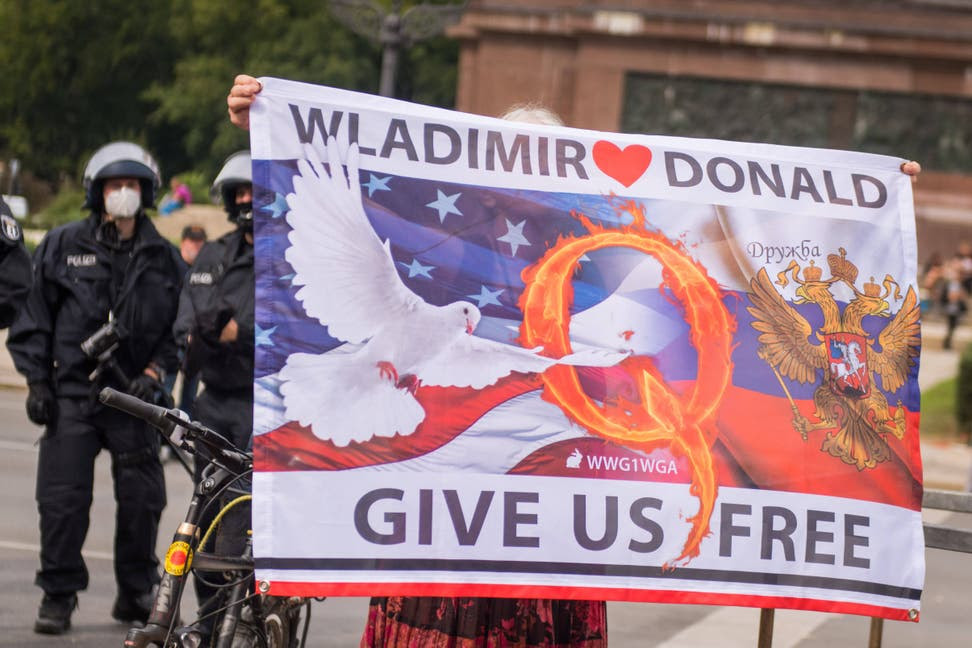Language and Metaphors
What role does language play in conspiracy theories?
When creating their reality, conspiracy theories build on the idea that the world is not as it appears. The goal is to expose supposedly hidden truths about the world and to this end, these theories often use stage metaphors, for example those suggesting that hidden figures are “pulling the strings,” that there are “puppeteers” and “string puppets.” This often refers to “the Jews” or “the Rothschilds,” a Jewish banking family. The creators of the theories cast themselves as those who “see behind the curtain” or who “bring the whole show down.” The dualism of light and dark is also central: “We are in the dark” and, at the same time, “a light is shone on things.” The language of conspiracy theories is clear and simple to make the message appear as convincing as possible. It aims to bowl people over. Words like “certain,” “clear,” and “obvious” make arguments appear plausible – as opposed to the official version of events. Some theories use an increased number of negations like “none” or “not.” The language is unambiguous; things are either black or white; the distinction between “good” and “evil” or “friend” and “enemy” is quickly made; there is no compromising and no shades of gray; anything complex is left out. Strong symbols and clear identities are assumed, and alleged enemies are demonized as “vermin invading the healthy body of the nation.”

The world according to conspiracy theories is fragile; often it seems to be on the brink of collapse. The theories conjure a scenario in which the system is overthrown or breaks down: they forecast a “white extinction,” that is an “extermination of the whites,” as part of a “repopulation,” or else they imagine a war or an apocalypse (“The world is teetering on the brink”). Metaphors of catastrophe like these are illustrated by, for example, images of the smoking towers and debris of the World Trade Center on September 11, 2001 (fig. 1 and 2) and images of the crashed Polish government plane in Smolensk on April 10, 2010 (fig. 3).

Fig. 1
“Terrorist attack on the World Trade Center,” September 11, 2001, New York City, USA, picture-alliance/dpa/dpaweb/Pentagon

Fig. 2
“Debris of the destroyed World Trade Center,” September 11, 2001, New York City, USA, Wikimedia Commons

Fig. 3
“Debris of the Polish government plane,” April 10, 2010, Smolensk, Russia, Wikimedia Commons

Fig. 4
“Protest against corona measures,” Berlin, August 30, 2020, picture-alliance/ dpa/NurPhoto/Achille Abboud

Fig. 5
“The Storming of the Capitol,” Washington D.C., USA, January 6, 2021, Wikimedia Commons
It is characteristic of conspiracy theories to repeat imagery that is often symbolic. Images of the so-called Storming of Berlin on August 30, 2020 became especially strong symbols (fig. 4). These images emerged when coronavirus deniers and right-wing extremists gained entry to the Reichstag building. They show protesters in front of the main portal that has the dedicatory inscription “To the German People.” By holding up flags used during the time of the German Empire and the Nazi period (the Reich’s flag), people made themselves look as if they were part of a large movement. The media effect of the pictures, supposedly showing that the symbol of German democracy had been stormed, was huge. The images served as a clear visual reminder that at one time Nazi Party members who had been elected to parliament had taken their seats there, their goal, of course, being to abolish democracy.
Pictures showing the so-called Storming of the Capitol on January 6, 2021 (fig. 5) had a similar effect. Numerous supporters of the former U.S. President Donald Trump, including members of the QAnon movement, who subscribe to their own conspiracy theory, called for Joe Biden’s election victory to be annulled and for Trump to be reinstated as president.
Conspiracy theory rhetoric is characterized today by the fact that it is often not recognizable as such right away. Vocabulary is used that is common in democratic discourse or this vocabulary is deliberately “coded.” Groups of the New Right like the “Engagierte Demokraten gegen die Amerikanisierung Europas” (Committed Democrats against the Americanization of Europe, shortened to EnDgAmE) and the festival “Pax Terra Musica” in Brandenburg use seemingly peaceful language. Germany’s Basisdemokratische Partei Deutschlands, which calls itself a grassroots democratic party and uses the short form “dieBasis,” calls for a departure from current corona policies. According to their statutes, they want “loving, peaceful interaction” in which “the humanity and personhood of the other are always respected.” This is the kind of language we expect from left-wing political groups, and it is language like this that makes it all the more difficult to recognize conspiracy theory content at first glance.

Fig. 6
“Wladimir ♡ Donald, Give us free,” a flag seen at a Querdenker (“Lateral Thinkers”) protest in Berlin, Wikimedia Commons
The acronym “WWG1WGA” is short for “where we go one, we go all” and is a right-wing rallying cry. It is used by the racist US QAnon movement. QAnon believes that the “deep state,” a state within the state, is conspiring against former US president Donald Trump. Wanting to support Trump in the presidential election in 2020, QAnon members used the acronym to find each other on Twitter. It then spread on TikTok until it was banned that same year.
What media platforms do conspiracy theorists use?
Conspiracy theorists reject public broadcasters and classic news formats. Web portals such as KenFM, Kla.tv or the “Compact-Magazin für Souveränität” (Compact Magazine for Sovereignty) specialize in conspiracy theory content and work to construct a parallel reality. Social media platforms like Telegram also contribute to spreading this content. However, while these channels are not part of the mainstream media in Germany, in countries with right-wing conservative governments such as Russia, Hungary, Romania, and Poland, conspiracy theories are actually spread by public broadcasters themselves, such as Russia Today, the Romanian TVR and the Polish TVP.




